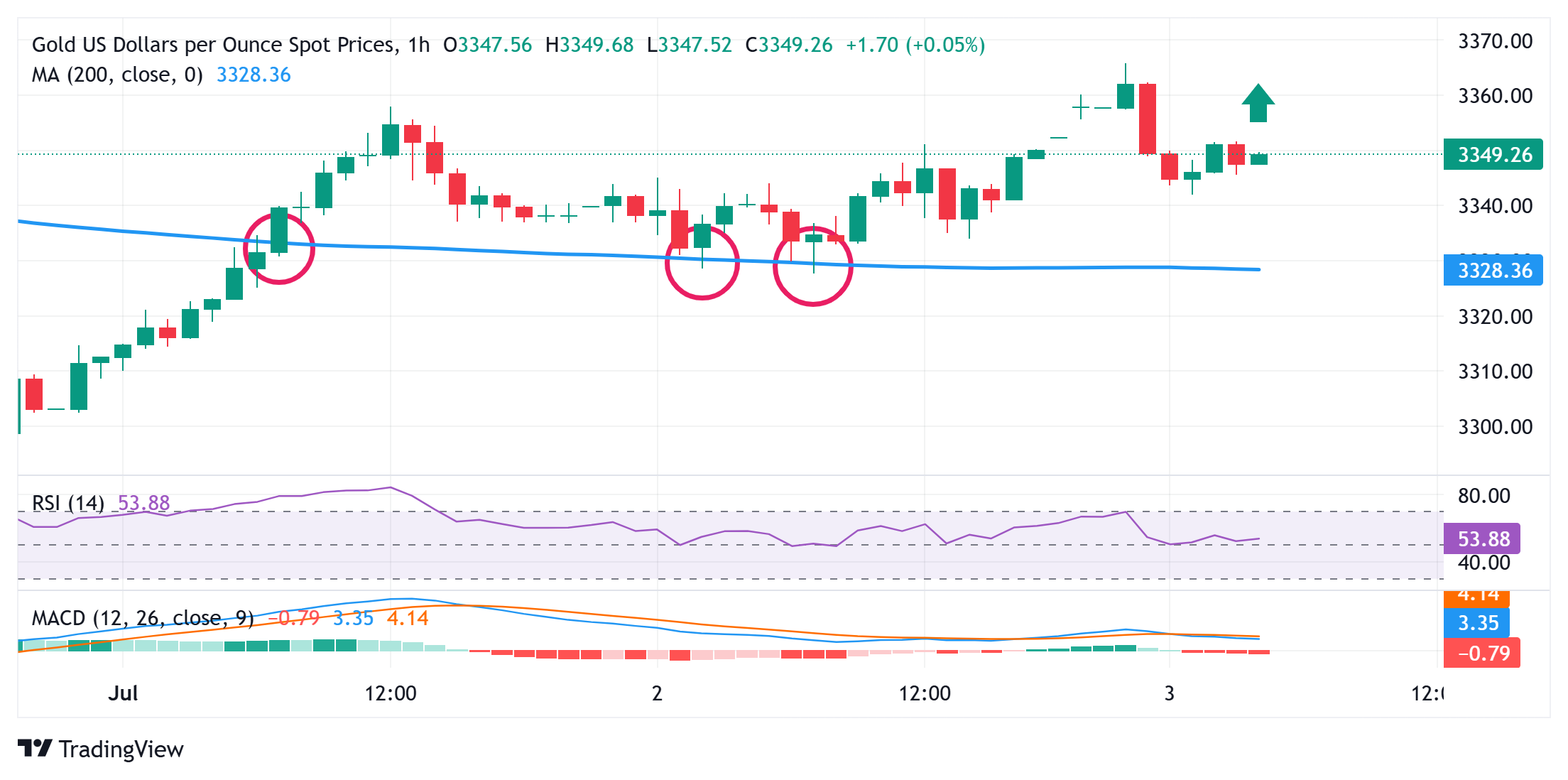Gold price drifts lower on US-Vietnam trade deal, NFP in focus

Gold price (XAU/USD) attracts some sellers during the Asian session on Thursday and, for now, seems to have stalled a three-day-old recovery move from a one-month low touched earlier this week. A trade agreement between the US and Vietnam eased concerns over prolonged trade tensions. Apart from this, a modest US Dollar (USD) uptick turns out to be another factor exerting some downward pressure on the safe-haven precious metal. Any meaningful depreciation for the commodity, however, seems elusive in the wake of dovish Federal Reserve (Fed) expectations.
In fact, traders seem convinced that the US central bank would resume its rate-cutting cycle in the near future. The bets were reaffirmed by Wednesday's disappointing release of the US ADP report on private-sector employment. This, along with concerns that the US fiscal condition could worsen further in the wake of US President Donald Trump’s budget bill, should cap the USD and support the Gold price. Traders now look to the USNonfarm Payrolls(NFP) report for cues about the Fed's rate-cut path and determining the near-term trajectory for the non-yielding yellow metal.
Daily Digest Market Movers: Gold price is pressured by positive risk tone, modest USD uptick
Gold price bullish technical setup backs the case for the emergence of some dip-buying
From a technical perspective, this week's breakout above the 200-hour Simple Moving Average (SMA) was seen as a key trigger for the XAU/USD bulls. Moreover, oscillators on the dailycharthave again started gaining positive traction and suggest that the path of least resistance for the Gold price is to the upside. Hence, any subsequent slide might still be seen as a buying opportunity and remain cushioned near the $3,330-3,329 region (200-hour SMA). A convincing break below, however, might prompt some technical selling and drag the commodity further towards the $3,300 round figure.
On the flip side, the $3,363-$3,365 zone, or over a one-week high touched on Wednesday, now seems to act as an immediate hurdle, above which the Gold price could aim to reclaim the $3,400 mark. A sustained strength beyond the latter would negate any near-term negative outlook and lift the XAU/USD pair to the next relevant hurdle near the $3,435-$3,440 region.
Gold FAQs
Why do people invest in Gold?
Gold has played a key role in human’s history as it has been widely used as a store of value and medium of exchange. Currently, apart from its shine and usage for jewelry, the precious metal is widely seen as a safe-haven asset, meaning that it is considered a good investment during turbulent times. Gold is also widely seen as a hedge against inflation and against depreciating currencies as it doesn’t rely on any specific issuer or government.
Who buys the most Gold?
Central banks are the biggest Gold holders. In their aim to support their currencies in turbulent times, central banks tend to diversify their reserves and buy Gold to improve the perceived strength of the economy and the currency. High Gold reserves can be a source of trust for a country’s solvency. Central banks added 1,136 tonnes of Gold worth around $70 billion to their reserves in 2022, according to data from the World Gold Council. This is the highest yearly purchase since records began. Central banks from emerging economies such as China, India and Turkey are quickly increasing their Gold reserves.
How is Gold correlated with other assets?
Gold has an inverse correlation with the US Dollar and US Treasuries, which are both major reserve and safe-haven assets. When the Dollar depreciates, Gold tends to rise, enabling investors and central banks to diversify their assets in turbulent times. Gold is also inversely correlated with risk assets. A rally in the stock market tends to weaken Gold price, while sell-offs in riskier markets tend to favor the precious metal.
What does the price of Gold depend on?
The price can move due to a wide range of factors. Geopolitical instability or fears of a deep recession can quickly make Gold price escalate due to its safe-haven status. As a yield-less asset, Gold tends to rise with lower interest rates, while higher cost of money usually weighs down on the yellow metal. Still, most moves depend on how the US Dollar (USD) behaves as the asset is priced in dollars (XAU/USD). A strong Dollar tends to keep the price of Gold controlled, whereas a weaker Dollar is likely to push Gold prices up.









_300xx250.jpg)
0 댓글